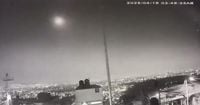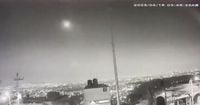On the early morning of April 16, 2025, the night sky of several cities in Mexico was illuminated by a spectacular event—a bright object, identified as a bolide, entered the Earth’s atmosphere, creating a stunning display and a loud explosion. Reports indicate that the phenomenon occurred around 3:46 AM, with many witnesses across Mexico City, the State of Mexico, and other central regions describing a brilliant flash followed by a thunderous sound that shook the ground.
Residents in areas such as Narvarte and western neighborhoods of Mexico City reported vibrations beneath their feet, prompting immediate speculation about a meteorite crash. Social media platforms were flooded with videos and comments as users shared their experiences and reactions to the event. The intense light and accompanying noise were significant enough to be detected by national seismographs, which initially raised concerns about a possible earthquake.
However, experts quickly clarified that what was observed was not a meteorite impact but rather a bolide—a type of meteor that disintegrates in the atmosphere. Pablo Lonnie Pacheco, an astronomy instructor and expert, explained the phenomenon in detail through social media, stating, “What we saw was not an asteroid or a meteorite. It was a bolide.” He elaborated that as the Earth moves through space, it encounters particles left behind by comets and asteroids, which can ignite and create bright streaks in the sky.
According to Sismo Alerta Mexicana, the explosion occurred at an altitude of approximately 20 to 40 kilometers, generating an acoustic wave that was powerful enough to be registered by their sensors. They noted, “Based on reports and our cameras, we confirm that the explosion in Mexico City was a bolide that exploded at about 40 to 44 kilometers above the ground, causing an acoustic wave.”
The bright object was seen from various locations, including Queretaro, Taxco, Guerrero, Mexico City, and near the Popocatepetl volcano, with many capturing the moment on video. The bright flash was described as being more luminous than Venus, a characteristic of bolides that are exceptionally bright. Pacheco noted, “The bolide was likely less than one meter in diameter, and upon entering the atmosphere at speeds around 30 kilometers per second, it generated enough friction to cause a violent disintegration.”
Interestingly, the event was not unique; research from the University of Manchester and Imperial College London indicates that approximately 17,000 meteorites fall to Earth each year, mostly in the form of tiny dust particles that go unnoticed. The majority of meteoroids that enter the Earth’s atmosphere are small grains of sand that burn up before they can reach the surface, creating what we commonly refer to as shooting stars.
Despite the excitement surrounding the event, experts reiterated that the vast majority of meteoroids do not survive their descent. Pacheco explained that when a meteoroid enters the atmosphere, it typically ignites and disintegrates, leaving only microscopic traces behind. “The perception that meteorites reach the ground engulfed in flames is a common misconception,” he stated. “In reality, only larger fragments, typically those over 30 meters in diameter, have the potential to reach the surface intact.”
As the morning unfolded, many took to social media to share memes and humorous takes on the event. The phenomenon sparked a wave of creativity online, with users expressing their awe and surprise at the unexpected display. Videos captured by security cameras showcased the intense light streaking across the sky, further fueling the buzz around the incident.
While no official confirmation has been released by local authorities regarding the exact location of any potential fragments, the sound resembling thunder and the vibrations felt by many suggest that the bolide exploded in the denser layers of the atmosphere, creating a shockwave similar to that of a lightning strike. This phenomenon, known as electrophone sound, occurs when radio waves from the bolide cause nearby objects to vibrate, producing a perceptible buzzing sound.
Experts also emphasized the scientific significance of such events. If fragments were to be recovered, they could provide valuable insights into the origins of the Solar System, as these remnants often contain primordial materials from asteroids and comets. Pacheco highlighted the importance of handling any recovered meteorites with care, ideally storing them in sterilized glass containers to avoid contamination.
In summary, the early morning spectacle of April 16, 2025, was a remarkable display of nature’s wonders, captivating residents and sparking curiosity about the cosmos. As people continue to share their experiences and videos online, the event serves as a reminder of the fascinating and dynamic universe we inhabit. While no meteorite impacted the Earth, the bolide’s fiery journey through the atmosphere provided an unforgettable moment for many.






